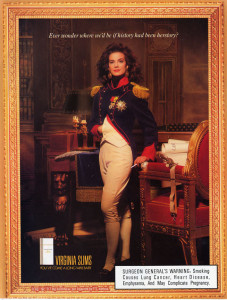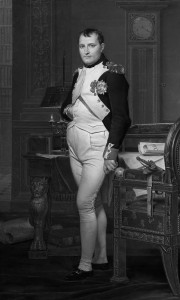The expansion of the Internet into news, entertainment, and leisure does not seem to have staunched the flow of printed magazines—available at airports, gas stations, grocery and drug stores. My neighbors were cleaning out a garage piled with old newspapers and periodicals when I came upon an August 1991 issue of Family Circle, whose spine offered the assurance that it was the “world’s largest-selling women’s magazine.” The back flap contained a full-page advertisement remarkable for its reliance on a well-known early nineteenth-century portrait.
A woman, undoubtedly a model in her early twenties, stands confidently in the foreground, turned forty-five degrees to the picture plane and clothed in French military garb, one hand thrust into a white waistcoat, the other resting on the arm of a gilded fauteuil and grasping a cigarette. Pale, even facial features are cosmetically enhanced with high arched eyebrows, deeply shaded cheeks, and broad red lips, the whole framed by a luxuriant chestnut mane floating two enormous gold spiral earrings. The narrow torso is augmented by a dark blue cutaway coat trimmed with red collar and cuffs, gold braid epaulettes, metallic buttons and medals; the slim legs are accentuated by white breeches and hose, terminating in black patent leather flats affixed with a gold buckle. The hands are the operative signs: while the position of the right is a popular synecdoche for the Emperor Napoleon I, and as such works with the empire uniform, setting, and frame to signify Jacques-Louis David’s Napoleon in His Study at the Tuileries (1812), the gesture of the left is meant to showcase a foreign object, namely Virginia Slims Cigarettes. The impact of the advertisement is thus derived from the viewer’s perception of the woman’s/product’s daring disruption of a visual sign system created by and for men to promote their authority. Two inscriptions clarify the nature of this disruption of visual coda: white script at the top queries, “Ever wonder where we’d be if history had been herstory?,” and yellow capitals at the bottom left declare, “YOU’VE COME A LONG WAY, BABY.” The message is forceful and unequivocal: after centuries of being excluded from the chief cultural and political events of history’s narrative, women are at last emancipated and ready to play and to record a part equal to that of a man.
And not just any man. Between 1800 and 1815, Napoleon Bonaparte presided over a series of military and diplomatic victories on the European Continent that allowed him to claim a French empire stretching from the Papal States to the Netherlands along with dependents and allies extending from Spain to Russia. First as Consul and then as Emperor, he also presided over the creation of a strong executive branch capable of reorganizing national and regional governments and instituting a new legal system (the Napoleonic Code) and civil service that oversaw public education, religious worship, tax collection, and law enforcement. To explore in greater depth how the interests of the commodity marketer compare with those of the art historian, it is necessary to consider the origins and content of David’s original portrait of Napoleon.
In 1810, an eccentric Scottish nobleman named Alexander Douglas, Marquis of Hamilton, commissioned David to paint a full-length image of Napoleon that would preside over a collection brimming with busts and miniatures of the Bonaparte family and an impressive array of Egyptian artifacts. Unlike his later female impersonator, the emperor shows sure signs of middle age: thinning hair and cautious gaze rest atop a slack and portly physique disposed in comfortable counterpoise. The uniform, augmented with white winged lapels held with gold buttons, can be identified as that of the Colonel of the Grenadiers of the Imperial Guard. The rendering of the right hand lightly slung into an opening in the vest accentuates his corpulence, and that of the left firmly clutching a gold snuffbox admits the importance of tobacco as a nighttime stimulant. Although a few planes have been flattened and furnishings inserted compared to the original sketch, the arrangement guarantees the balance of horizontals and verticals typical of neoclassical painting. The eye is admitted to this private space only by degrees: the red velvet settee angled like the figure, the mahogany trestle bureau affixed with a lion and piled with writing implements, the wall articulated at the left edge by a monumental pilaster filigreed with grotesques and at the right by a tall case clock registering 4:13 a.m., the recess filled with books—all attributes of the emperor’s private suite at the Château de Tuileries. The low-burning lamp and the early hour of the clock suggest that the emperor has been up all night reading and drafting documents. David himself remarked that he intended it to seem like Napoleon had been hard at work writing the Code Napoléon, signified by a partial inscription on the scroll at right, yet this was hardly to be believed since the Code was a collaborative effort and had been in effect for years. But David was successful in promoting the legend of the emperor tirelessly working for the welfare of his subjects. As sunrise approaches, he rises from his desk, adjusts his uniform, and fastens his sword in preparation to review of the foot soldiers. In this way, he encompasses both civil and military aspects in his person and identity; battles in foreign fields may well have brought him to the elevated position he now holds, but administrative responsibilities at home are consuming an increasingly large share of his time.
Even before Napoleon’s reign had ended, viewers compared the portrait to slightly earlier fare. Alexandre Lenoir, archeologist and head of the Musée des monuments français, proclaimed it the best likeness ever made of the emperor, the image of a lawgiver among his papers being the perfect companion to that of a conqueror traversing the Alps. Closer to today, Albert Boime embraced this comparison between Napoleon Crossing the Alps (1801) and the Napoleon in His Study (1812) for the purpose of exploring the relative proportions of mythology (his word is “ideology”) and reality in each. As portraits, both are idealized depictions, but whereas the former invested the active body of the hero with ideal qualities, the latter accorded to the inanimate objects surrounding the body with them. In other words, the master of the surprise attack has now become a prisoner of paperwork.
Scholars take as axiomatic the idea that Imperial state portraits evidence a clean break with the ancien régime‘s religio-political values, if not always its sign systems: the ancient emblems and medieval regalia that they bear can signify antiquarianism or historical anecdote but never transcendent powers. This may well have been true for many post-Revolutionary viewers, intent as citizens were to break with past political institutions, but it was likewise true that painters built on past visual traditions, among which the eighteenth century’s small- to mid-sized cabinet portraits featuring clerics, aristocrats, and financiers, male and female, engaged in reading or writing within the confines of their libraries and boudoirs, figured prominently. It only remained for a head of state to express the desire to be so represented on a grand scale before a large audience for this domestic occupation to be understood as a political virtue. Napoleon appears to have been the first to embrace this strategy. Thus, David’s portrait of Bonaparte represents a measure of continuity with the Bourbon past, suggesting that the emperor not only bears the martial and legal obligations of modern statecraft but also continues the creative and thoughtful pursuits of the republic of letters.
Mention of women’s contributions to Enlightenment texts and images brings us back to Virginia Slims’ use of a model to travesty Napoleon’s portrait. In 1968 the Phillip Morris Company targeted young professional women with a longer, slimmer, and smoke-reducing cigarette. Its marketing consultants, aware of the potential of modeling shots to be seamlessly integrated into realist paintings, conceived the strategy of substituting a young mannequin for a middle-aged monarch. Women’s liberation, it was suggested, consists of being able to appear and to act like a man, as signified by the assumption of military dress and the possession of tobacco. Of course, this only gives rise to more questions. If women’s empowerment over inequities past and present is predicated on her ability to be like a man, does that not constitute a reinforcement of patriarchal values, in this case militant and autocratic ones? Further, if women’s empowerment is facilitated by the consumption of tobacco, does this not contribute to capitalist abuses, the exploitation of labor and the onset of lung cancer? Consumers might have been served better with a portrait of Madame de Pompadour or Catherine the Great standing before a desk piled with papers, holding a cup of Gevalia Kaffe, and pondering, “How might herstory be written?” or “What will herstory say?” Establishing this narrative continues to be a complicated and contested business.


